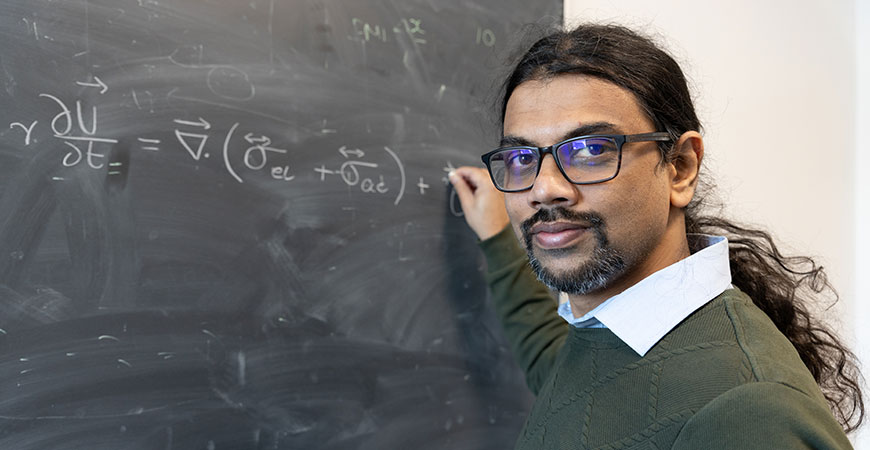
Department of Physics Professor Kinjal Dasbiswas has received a CAREER award for his work on the theory and modeling of shape-changing active solids.
He is the 38th researcher from UC Merced to earn this award from the National Science Foundation (NSF).
CAREER awards are among the NSF’s most prestigious awards. They are given through the Faculty Early Career Development Program to recognize untenured faculty members as teacher-scholars. Early-career faculty members are selected based on three factors: the strength of their research proposals; their potential to serve as academic role models in research and education; and their leadership in their field and organizations.
Dasbiswas will receive $630,000 over the next five years for the project “Self-organization and Shape Change in Elastic Active Matter.” The award comes from the Condensed Matter and Materials Theory program under the Division of Materials Research of the NSF.
Dasbiswas and his lab focus on soft matter and biological physics theory, specifically active matter and mechanobiology.
“Professor Dasbiswas’ work focuses on an exciting new direction in soft matter and biophysics. The field of active solids is a relatively unexplored area of physics, and this award will help us to bring in some of the best young researchers,” Department of Physics Chair Professor Linda Hirst said. “I am also very excited about the computational workshops that Professor Dasbiswas is planning. I expect that these projects will encourage more students to explore physics as a possible degree path at UC Merced.”
Active matter — one of the frontier areas of physics research — refers to how collections of energy-consuming units organize into complex, large-scale patterns.
“Such patterns exist everywhere in the natural world around us, from flocks of birds and schools of fish to the microscopic world of bacteria and molecular motors in our cells,” he said. “The better-studied models of active matter involve units that are free to move and show fluid-like behavior. Biological materials in our body's cells and tissues are, on the other hand, more like soft, rubbery solids.”
His research group takes direct inspiration from such biological materials occurring in the cytoskeleton of a cell or collections of cells in the extracellular matrix and creates models for active solids, as opposed to active fluids.
“The distinguishing feature of solids is that they resist deformation — they push back on you if you push on them, as opposed to a fluid which just flows away. We model biological materials as connected networks of elastic springs that are under deformation from mechanical forces produced by cells and molecular motors,” Dasbiswas explained.
In living systems, the configuration of these springs and the pattern of forces acting on them change over time because of chemical signals. These factors working together result in shape-changing active solid behavior important for crucial biological processes such as tissue development, wound healing or muscle contraction.
“We build models for such spontaneously shape-changing active solids by considering the mechano-chemical feedback ubiquitous in biology. Together with our experimental colleagues across multiple institutions and disciplines, we test our ideas on real biological systems such as cytoskeletal extracts and blood clots,” he said. “Our work has potential applications in tissue engineering, which could lead to organs designed in the lab, as well as to the design of smart shape-shifting materials.”
Overall, the work exemplifies not only how physics-based modeling can help understand biological processes, but also how biology can inspire new physics models for material behavior out of equilibrium, he said.
Dasbiswas has been with UC Merced since 2018. He is affiliated with the Center for Cellular and Biomolecular Machines, the Health Sciences Research Institute and a newly formed National Institutes of Health graduate training grant collaborative called the Interdisciplinary Biomedical Science and Technology Program .
“The award feels like a great recognition of all the hard work put in by my research group, comprising four graduate students, two former postdocs and a few undergraduate students,” Dasbiswas said. “Practically, this award will also let me recruit and support a postdoc and a graduate student researcher for the next few years.”
Each CAREER award proposal includes an educational outreach component, and Dasbiswas plans to develop computational modeling workshops that use biology examples for middle-and-high school students, undergraduate students taking physics classes as well as science, technology, engineering and mathematics (STEM) graduate students.
“My focus on integrating computation in the training of STEM students arises from a well- recognized need in this area. While traditional physics classes train students in simple, exactly solvable models, many recent advances in research are made through computational and data-driven approaches. This may pose significant barriers to entry into research for beginners,” Dasbiswas said.
He developed a new graduate class and computational modules for outreach and undergraduate learning, which are part of his sustained efforts to fill these gaps in curriculum.
“As a new and growing university serving a large under-represented student demographic, I believe these efforts are even more critical at UC Merced in terms of training up a future STEM workforce in the Central Valley,” he said.
Although he is a physicist, he is also an interdisciplinary researcher and said he is particularly interested in making physics more accessible to students specializing in other areas of science, and specifically life science majors.
“My work at UC Merced will be part of a national initiative to redesign introductory physics classes for life science majors, specifically to engage them with bio-related examples,” he said. “This is a need that I felt I was uniquely qualified to contribute to.”
He had many thanks to share after receiving the CAREER award.
“I feel very thankful to the NSF and the soft matter and biophysics community for deeming my work to be suitable for this award. I am also grateful for the students, collaborators and colleagues, especially those who helped me navigate the environment at UC Merced and set up an active research group, as a beginning assistant professor,” Dasbiswas said. “I am delighted to have this recognition for my research and educational program.”




